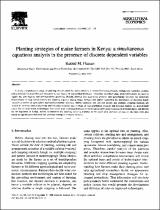 ResearchSpace
ResearchSpace
Planting strategies of maize farmers in Kenya: a simultaneous equations analysis in the presence of discrete dependent variables
JavaScript is disabled for your browser. Some features of this site may not work without it.
- ResearchSpace
- →
- Research Publications/Outputs
- →
- Journal Articles
- →
- View Item
| dc.contributor.author |
Hassan, RM

|
en_US |
| dc.date.accessioned | 2007-04-02T09:04:30Z | en_US |
| dc.date.accessioned | 2007-06-07T10:08:17Z | |
| dc.date.available | 2007-04-02T09:04:30Z | en_US |
| dc.date.available | 2007-06-07T10:08:17Z | |
| dc.date.copyright | en_US | |
| dc.date.issued | 1996-11 | en_US |
| dc.identifier.citation | Hassan, RM. 1996. Planting strategies of maize farmers in Kenya: a simultaneous equations analysis in the presence of discrete dependent variables. Agricultural Economics, vol. 15(2), pp 137-149 | en_US |
| dc.identifier.issn | 0169-5150 | en_US |
| dc.identifier.uri | http://hdl.handle.net/10204/2184 | en_US |
| dc.identifier.uri | http://hdl.handle.net/10204/2184 | |
| dc.description.abstract | A fairly comprehensive range of planting choices made by maize farmers in Kenya (including discrete endogenous variables creating self-selectivity) is modelled and estimated as one system of interrelated decisions. Two-stage and three-stage probit procedures are used to handle the simultaneity and self-selectivity problems. Results showed that population pressure and agroclimatic diversity are important determinants of crop intensification and planting regimes among maize farmers and further supported the importance of focusing maize research in terms of agroclimate and socio-economic domains. Shorter maturity and efficient double and multiple cropping methods are needed to increase land productivity and intensity of labour use in areas of high population pressure and bimodal rainfall, i.e. mid-altitude zones. On the other hand, technologies that would lead to increased productivity of capital and higher response to external inputs are desired for the highlands of Kenya. Access to extension and machine services, distance to the maize plot, and time of onset of the rains were also found to significantly influence the planting strategies of maize farmers. | en_US |
| dc.format.extent | 1084302 bytes | en_US |
| dc.format.mimetype | application/pdf | en_US |
| dc.language.iso | en | en_US |
| dc.publisher | Elsevier Science BV | en_US |
| dc.rights | Copyright: 1996 Elsevier Science BV | en_US |
| dc.source | en_US | |
| dc.subject | Planting strategies | en_US |
| dc.subject | Maize farmers | en_US |
| dc.subject | Agroclimatic diversity | en_US |
| dc.subject | Kenya | en_US |
| dc.title | Planting strategies of maize farmers in Kenya: a simultaneous equations analysis in the presence of discrete dependent variables | en_US |
| dc.type | Article | en_US |
| dc.identifier.apacitation | Hassan, R. (1996). Planting strategies of maize farmers in Kenya: a simultaneous equations analysis in the presence of discrete dependent variables. http://hdl.handle.net/10204/2184 | en_ZA |
| dc.identifier.chicagocitation | Hassan, RM "Planting strategies of maize farmers in Kenya: a simultaneous equations analysis in the presence of discrete dependent variables." (1996) http://hdl.handle.net/10204/2184 | en_ZA |
| dc.identifier.vancouvercitation | Hassan R. Planting strategies of maize farmers in Kenya: a simultaneous equations analysis in the presence of discrete dependent variables. 1996; http://hdl.handle.net/10204/2184. | en_ZA |
| dc.identifier.ris | TY - Article AU - Hassan, RM AB - A fairly comprehensive range of planting choices made by maize farmers in Kenya (including discrete endogenous variables creating self-selectivity) is modelled and estimated as one system of interrelated decisions. Two-stage and three-stage probit procedures are used to handle the simultaneity and self-selectivity problems. Results showed that population pressure and agroclimatic diversity are important determinants of crop intensification and planting regimes among maize farmers and further supported the importance of focusing maize research in terms of agroclimate and socio-economic domains. Shorter maturity and efficient double and multiple cropping methods are needed to increase land productivity and intensity of labour use in areas of high population pressure and bimodal rainfall, i.e. mid-altitude zones. On the other hand, technologies that would lead to increased productivity of capital and higher response to external inputs are desired for the highlands of Kenya. Access to extension and machine services, distance to the maize plot, and time of onset of the rains were also found to significantly influence the planting strategies of maize farmers. DA - 1996-11 DB - ResearchSpace DP - CSIR KW - Planting strategies KW - Maize farmers KW - Agroclimatic diversity KW - Kenya LK - https://researchspace.csir.co.za PY - 1996 SM - 0169-5150 T1 - Planting strategies of maize farmers in Kenya: a simultaneous equations analysis in the presence of discrete dependent variables TI - Planting strategies of maize farmers in Kenya: a simultaneous equations analysis in the presence of discrete dependent variables UR - http://hdl.handle.net/10204/2184 ER - | en_ZA |





